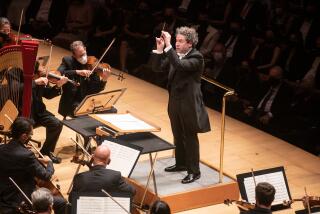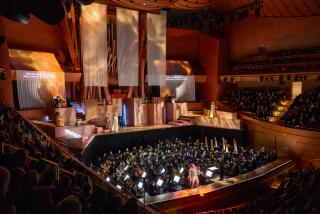Review: L.A. Phil ‘Rites’ of passage for Gustavo Dudamel
Gustavo Dudamel, Angeleno. He’s getting there.
He owns a house with a pool in Los Feliz. He drives a Porsche. His son, Martín, was born here. And he has, in his first three seasons as music director of the Los Angeles Philharmonic, shown admirable locavore tendencies in his programming as well as his reaching out to L.A.’s underprivileged youth.
But until Friday night, Dudamel had yet to acknowledge two essential L.A. Phil traditions. For his first subscription concert of his fourth season, he premiered a new score by Steven Stucky, a composer with a near-quarter-century connection to the orchestra. Dudamel also led his first performance in Walt Disney Concert Hall of Stravinsky’s “The Rite of Spring,” a work with a nearly 90-year key connection to the 93-year-old orchestra.
Dudamel opened the program with Ravel’s “Pavane for a Dead Princess,” which seemed, at least on paper, a poor idea, as if a leftover crowd pleaser had fallen off a plate from the previous night’s opening gala. But when Dudamel began with shimmering quiet and an awe-struck audience let it happen, the Pavane proved a magical mood setter for Stucky’s stirring new symphony.
In his UpBeat Live talk before the concert, Stucky called his L.A. years “the making of me.” Literally a composer’s composer, he was hired as composer-in-residence by André Previn in 1988 and served as Esa-Pekka Salonen’s sidekick throughout the Finnish composer’s 17-year tenure as music director. An L.A. Phil commission, Stucky’s Second Concerto for Orchestra, won a Pulitzer Prize in 2005.
Stucky’s Symphony is also an L.A Phil commission (co-commissioned by the New York Philharmonic, which will perform it in late November). It lasts a modest 19 minutes, and it has four interconnected movements, each with a descriptive title — “Introduction and Hymn,” “Outcry,” “Flying,” “Hymn and Reconciliation.”
Stucky tends to be a sanguine composer; no matter how serious the score, some sunshine can usually be counted on. Part of that may be less an easygoing quality than his ability to create the sensation of illumination, to suggest light through exquisitely applied color.
What makes this a symphony, Stucky said, are the musical materials, which are weighty and suited for development. But he is not one to give himself away in his music. His symphony leaves the listener with the sense that there are layers, maybe undetected but providing a sense of substance and uncertainty underlying the confident surface.
The score begins with a plaintive oboe solo, memorably played Friday by Marion Arthur Kuszyk, but the winds absorb it. “Outcry” is powerful, not cataclysmic: What is held back can be more moving than what is revealed. “Flight” is full of fancy, brightly lighted. The final movement is a graceful coming together, less resolution than acceptance.
No note felt wasted. To hear Stucky’s Symphony once was to want to hear it again. Given that this was a program with only an hour’s worth of music, playing it a second time wouldn’t have been unwarranted.
No orchestra owns Stravinsky’s “Rite,” though few this season are ignoring the centenary of its 1913 riot-causing Parisian premiere. Still, the L.A. Phil DNA certainly has more “Rite” in it than most. Eugene Goosens first conducted the score with the orchestra in 1923. I remember a performance at the Hollywood Bowl conducted by Robert Craft with Stravinsky, who lived in L.A. longer than anywhere else in his life, in the audience. Zubin Mehta put the piece on the program for the opening week of the Dorothy Chandler Pavilion in 1964. Salonen opened Disney Hall with it in 2003 and made every subsequent Disney performance an event.
Conducting the “Rite” from memory (as did Mehta), Dudamel offered a commanding performance, one very different from any of his predecessors. Whitney Crockett’s opening bassoon solo set a soulful tone, but the excitement quotient was often exceedingly high. The young princesses alluded to in “The Augurs of Spring” became no slight things but earth movers.
Dudamel seemed to want at times to break records for speed (maybe he’s been spending too much time in that Porsche). But he also enjoyed slowing way down and letting an eerie, lush orchestral soundscape take over. All that was quite effective. You felt the “Rite” come through the floor and the seats, you sensed a tingling atmosphere in the hall, which is as it should be in Disney.
But with the great “Sacrificial Dance” at the end, where the accents are unpredictable, Dudamel turned excitement into overexcitement, mathematical irregularity into chaos. He roared through victoriously to the end but with causalities. Clarity suffered the most.
The orchestra, however, was not about to be the sacrificial victim. Dudamel asked for, and pretty much got, something approaching superhuman execution. The brass section has new members — Thomas Hooten, principal trumpet, and Nitzan Haroz, principal trombone. It sounded splendid.
MORE:
CRITIC’S PICKS: Fall Arts Preview
TIMELINE: John Cage’s Los Angeles
More to Read
The biggest entertainment stories
Get our big stories about Hollywood, film, television, music, arts, culture and more right in your inbox as soon as they publish.
You may occasionally receive promotional content from the Los Angeles Times.







